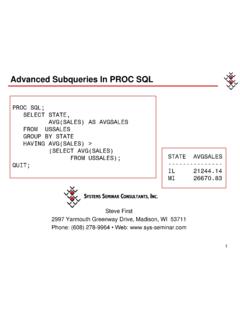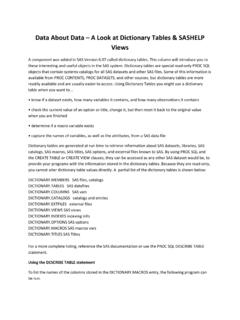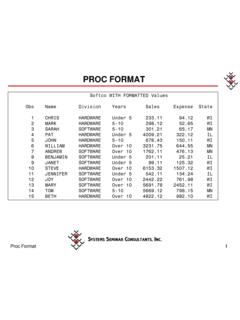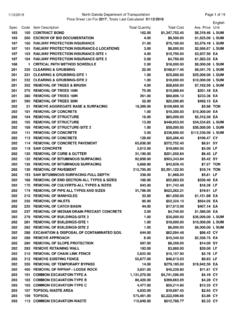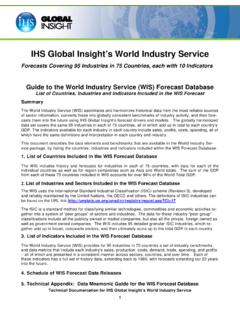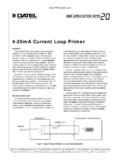Transcription of Understanding the SAS® DATA Step and the …
1 Understanding the SAS data step and the Program data Vector Steven J. First, President 2997 Yarmouth Greenway Drive, Madison, WI 53711. Phone: (608) 278-9964, Web: Understanding the SAS data step and the Program data Vector 1. Understanding the SAS data step and the PDV. This presentation was written by Systems Seminar Consultants Consultants, Inc Inc. SSC specializes SAS software and offers SAS: Training Services Consulting Services Help Desk Plans Newsletter subscriptions to The Missing Semicolon . Semicolon . SAS is a registered trademark of SAS Institute Inc. in the USA and other countries. The Missing Semicolon is a trademark of Systems Seminar C. Consultants, lt t Inc. I. Understanding the SAS data step and the Program data Vector 2. Global Warming Part 1. Understanding the SAS data step and the Program data Vector 3.
2 Abstract Th SAS system The t is i made d up off SAS PROCs PROC and d the th data step St The data step has: an excellent, full fledged programming language statements to read and write almost any type of data value Conversion and calculation of new data Looping Interfaces y Arrays Much, much more. In many ways, ways the design of the data step along with its powerful statements, is what makes the SAS language so popular. Understanding the SAS data step and the Program data Vector 4. Abstract (continued). This paper will Thi ill address: dd How the data step fits with the rest of the SAS System data step assumptions and defaults internal structures such as buffers, and the Program data Vector compiler statements executable statements Understanding the SAS data step and the Program data Vector 5. Introduction The SAS system's Th t ' origins i i are in i the th 1960's 1960' and d 1970'.
3 1970's with: ith James Goodnight John Sall A. J. Barr others Concepts in the design include: self defining files . y a system of default assumptions p procedures for commonly used routines data handling step that would evolve into the SAS data step Understanding the SAS data step and the Program data Vector 6. Introduction The data step Th t in i my opinion: i i extremely simple elegant design continues today 30 years of enhancements. Understanding the SAS data step and the Program data Vector 7. Structure of SAS. SAS consists i t of:f 1. a data handling language ( data step ). 2. a library of pre-written procedures ( PROC step ). S A S S A S. STATEMENTS SUPERVISOR. RAW SAS SAS SAS. data data data PROC REPORT. step SET step . Understanding the SAS data step and the Program data Vector 8. Purpose of the data step Gett th G the d data t iin shape.
4 H ffor llater t PROC. PROCs and d data steps. t SAS PROCs can only read SAS datasets We might have some other type of file to process SAS dataset has built in descriptor that keeps track of names and attributes later steps don't have to remember as many details If we don't have well defined data data step gives us the power to read and write virtually any kind of file We can do calculations and computations on a single row of data It has a very powerful data handling language Understanding the SAS data step and the Program data Vector 9. SAS data step Overview data steps t can read d and d write it mostt types t off data d t stored t d on your computer. t other raw DBMS, instream SAS disk, program data d dataset tape products d SAS/ACCESS. get the data in shape for analysis S S/ CC SS. SAS/ACCESS. other raw reports DBMS, instream SAS disk, program data dataset tape products Notes: data step output is usually a SAS dataset but can be other files files.
5 Access to non-SAS database management systems requires a SAS/ACCESS product. Understanding the SAS data step and the Program data Vector 10. Default Assumptions M. Many assumptions ti are made d tto save titime and d effort. ff t As computer scientist I study and use many programming languages Early on I was intrigued by the cleverness and common sense of SAS. Many tedious programming tasks were eliminated through defaults System still provided a means to override those defaults when necessary Our job as a data step programmer then is different from other languages In many ways our tasks are: Understanding the defaults knowingg how to work with them override them as necessary. Understanding the SAS data step and the Program data Vector 11. Default Assumptions (continued). E. Examples l Of SAS D. Defaults: f lt Handling compile and execution naming and storage details A dataset descriptor that makes SAS datasets self defining.
6 Generating data set names if omitted When reading a data set, assume most recently created dataset if not specified Processing all the rows and columns in a file Automatically opening and closing of files Automatically controlling data initialization data step looping, data set output, and end of file checking Understanding the SAS data step and the Program data Vector 12. Default Assumptions (continued). E. Examples l Of SAS D. Defaults: f lt Automatically defining storage areas for each variable referenced without needd tto predefine d fi th them A default length of 8 was assumed for all variables A assumption that a variable is numeric if not specified LIST input assumed that data values would be separated by blanks rather than specifying exact columns SUBSETTING IF statements which imply to continue processing if a condition diti isi true, t else l delete d l t the th observation.
7 B ti (E. (Ex. If rate t > 10;. 10 ). When no comparison is made in an IF statement, assume to be checking for 1 (true) (Ex. If eof then put At end';). Ab i t d sum statements. Abreviated t t t (Ex. (E Salestot+sales). S l t t l ). Understanding the SAS data step and the Program data Vector 13. Compiling a data step A mostt languages, As l the th data step t isi fifirstt compiled il d th then executed. t d Languages can be compiled, interpreted, SAS is a hybrid language Some features from other languages Some unique features Sometimes difficult to separate compile versus execution events with SAS. data step compiler examines SAS statements for syntax data structures generates an executable program q to SAS compiler Unique p checking g for the existence of resources Assumptions that it inserts into the source code. Understanding the SAS data step and the Program data Vector 14.)
8 data Structures G tti the Getting th data d t in i shape . h needs d data d t structures t t to t hold h ld data d t as processed. d All computer languages need to address this Each language may name the structures differently There is a lot of similarity in the way most languages store data . Understanding the SAS data step and the Program data Vector 15. A Typical SAS Job 1234567890123456789012345678901234. BETH H 12 input buffer CHRIS H 2 JOHN H 7 data softsale;. ;. infile rawin;. input name $1-10 division $12 years 15-16 sales 19-25 expense 27-34;. run;. Name: NAME DIVISION YEARS SALES EXPENSE _ERROR_ _N_. PROGRAM Type: CHAR CHAR NUM NUM NUM NUM NUM. data Length: 10 1 8 8 8 8 8. VECTOR Format: Informat: Label: Flags: D D. Value DATASET. DESCRIPTOR Name: NAME DIVISION YEARS SALES EXPENSE. PORTION Type: CHAR CHAR NUM NUM NUM.
9 (DISK). ( ) Length: g 10 1 8 8 8. Format: Informat: Label: BETH H 12 DATASET CHRIS H 2 data JOHN H 7 PORTION. Understanding the SAS data step and the Program data Vector 16. Raw File Buffers data steps t reading/writing di / iti raw . or non-SAS. SAS data d t needd memory buffers. b ff Needed to temporarily hold at least one input record at a time. Also times when multiple lines of input can be held in buffers Allows the program to logically read later rows before earlier ones. Buffer contains the complete input and output record, regardless of whether the INPUT statement reads all of the columns. SAS datasets and RDMS (which usually appear as SAS datasets) do not use raw buffers as the files are already in shape . Understanding the SAS data step and the Program data Vector 17. Raw File Buffers 1234567890123456789012345678901234.
10 BETH H 12 input buffer CHRIS H 2 JOHN H 7 data softsale;. infile rawin;. input name $1-10 division $12 years 15-16 sales 19-25 expense 27-34;. run;. Name: NAME DIVISION YEARS SALES EXPENSE _ERROR_ _N_. PROGRAM Type: CHAR CHAR NUM NUM NUM NUM NUM. data Length: 10 1 8 8 8 8 8. VECTOR Format: Informat: Label: Flags: D D. Value DATASET. DESCRIPTOR Name: NAME DIVISION YEARS SALES EXPENSE. PORTION Type: CHAR CHAR NUM NUM NUM. (DISK). ( ) Length: g 10 1 8 8 8. Format: Informat: Label: BETH H 12 DATASET CHRIS H 2 data JOHN H 7 PORTION. Understanding the SAS data step and the Program data Vector 18. The LOGICAL PROGRAM data VECTOR (PDV). A second d memory area ffor data d t manipulation, i l ti conversion, i refinement. fi t Areas are needed for: Inputting and input formatting (informatting) desired variables Revising existing values Computing new variables System indicators and flags Called Logical Program data Vector (PDV).

